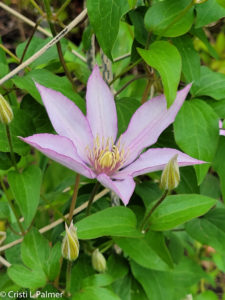 Plant Information
Plant Information
Clematis is a genus in Ranunculaceae (buttercup family) and is commonly known as clematis, but another name for this climbing vine is leather flower. The name comes from the Greek klema, which means “climbing vine.” Most are woody, deciduous vines although some are evergreen. While many species are native to Asia, they are also found in Europe, North America, and Australia. Clematis have great variety in flower form, color, bloom season, plant height and fragrance; all factors that contribute to their reputation as “queen of the vines.”
They feature opposing leaves, and stems divide into stalks and leaflets that twist around supporting structures for stability, and to anchor the plants as they curl and climb. They can grow in zones 3-11, depending on species. Clematis can cover posts, pergolas, arbors and fences, grow across the ground or drape from a container. Each season one plant may grow up to 8 feet but new plants may take a few years to reach their full growth potential. Flowers vary in size but can grow up to 8 inches wide.
Clematis leaves and sap are considered toxic to dogs, cats and horses. Fatalities are rare, due to the rapid and intense bitter taste and mouth irritation from eating. For sensitive individuals, contact dermatitis can result in skin redness and burning sensation so gardening gloves are recommended.
Planting and Maintenance
Clematis has gained a reputation as being difficult to grow, mainly due to confusion over pruning techniques and time. Pruning will depend on when the plant you chose flowers and the age of the wood that they flower on. In order to determine best practices, use the following guidelines that align with the group in which your chosen variety belongs:
- Group 1, or early-blooming varieties, will flower from March to June and bloom on old wood. Prune lightly immediately after flowering. This group is made up of evergreen and deciduous varieties.
- Group 2, or the mid-season bloomers, will flower from April to June and bloom on both old and new wood. Prune lightly in early spring. This group is made up of deciduous varieties.
- Group 3, or the late bloomers, will flower from July until the first frost, and bloom on new wood. Prune hard (down to 12″ to 24″) in late winter/early spring. This group is made up of deciduous varieties.
Most plants prefer 6 hours of sun but in areas with hot summers, they will need afternoon shade. Also, varieties with large, darker colored flowers can fade if they get too much sun. Small blooming varieties are better placed in full sun, while large flowers do better in lightly shaded sites. Moist, well-drained soil with a neutral to slightly alkaline pH is recommended. Incorporate compost or planting mix in the soil to improve aeration and drainage if needed. Add a 2-inch layer of mulch to provide a cool root environment.
The planting site should be open enough to allow for air movement while protection from strong winds is also desirable. Water deeply once a week in dry seasons. Vines need at least an inch of water a week, either from rain or irrigation.
Economics
According to the USDA NASS Census of Horticulture, clematis sold for a wholesale value of $10.7 million in 2014 and $10.4 million in 2019.
Main Diseases Problems
Clematis have several main disease problems including clematis wilt, root rot, leaf spot, rusts and powdery mildew.
Main Pest Problems
Armored and soft scale, thrips, aphids, slugs and whiteflies.
IR-4 Research
Most of the research IR-4 has sponsored has been related to crop safety (45 trials and 13 products)
References
https://hgic.clemson.edu/factsheet/clematis/
https://en.wikipedia.org/wiki/Clematis
https://gardenerspath.com/plants/flowers/grow-clematis/
https://www.nass.usda.gov/Surveys/Guide_to_NASS_Surveys/Census_of_Horticultural_Specialties/index.php
https://lee.ces.ncsu.edu/2017/02/clematis-climbers/
https://plants.ces.ncsu.edu/plants/clematis/
